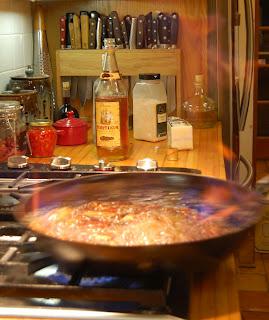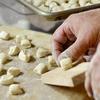 Flambéing is a cooking technique in which alcohol is added to a hot pan to create a surge of flames. The word flambé means “flamed” in French and is most often associated with tableside presentation of certain liqueur-drenched desserts, such as bananas Foster, Crêpes Suzette or cherries jubilee. It is also a procedure used in making coq au vin and other sauces, using spirits, before they are brought to the table. Although the practice of igniting food for show can be traced to the Moors in the 14th century, modern flambéing became popular in the late 19th century.
Flambéing is a cooking technique in which alcohol is added to a hot pan to create a surge of flames. The word flambé means “flamed” in French and is most often associated with tableside presentation of certain liqueur-drenched desserts, such as bananas Foster, Crêpes Suzette or cherries jubilee. It is also a procedure used in making coq au vin and other sauces, using spirits, before they are brought to the table. Although the practice of igniting food for show can be traced to the Moors in the 14th century, modern flambéing became popular in the late 19th century.By rapidly burning off the volatile alcohol, flambéing can infuse a dish with additional aroma and flavor, and moderates the harshness of raw, high-proof spirits. The flames result from the partial combustion of the flammable alcohol, which is quickly consumed, while some residual flavor remains. Only liquors and liqueurs with a high alcohol content can be used to flame foods, and those with a higher proof will ignite more readily. Beer, champagne, and most table wines will not work. Liquors and liqueurs that are 80-proof are considered the best choices for flambé. Those above 120-proof are highly flammable and considered dangerous. While there is debate as to whether flambéing effects the flavor of dishes, it is an indicator as to when the alcohol has finished vaporizing.
Safety Tips:
- A sauté pan, large skillet, or large chafing dish with rounded, deep sides and a long handle works best for this technique.
- Always remove the pan with the sauce from the heat source before adding the liquor to avoid burning yourself.
- Never pour liquor from a bottle into a pan that is near an open flame (the flame can follow the stream of alcohol into the bottle and cause it to explode). Pour the alcohol from a fire-proof vessel like a Pyrex measuring cup.
- Once you add the liquor to the pan, do not delay lighting. You don't want the food to absorb the raw alcohol and retain a harsh flavor.
- Always ignite the fumes at the edge of the pan and not the liquid itself.
- Ignite with a long match or a long barbecue lighter to avoid burned fingers and hands.
- When attempting to flambé tableside, light the dish at the table as far away from guests and flammable objects as reasonably possible.
- If the dish doesn't light, it's probably not warm enough. Cold/refrigerated liquor will not ignite; if cooler than room temperature, you can heat it briefly in a microwave or in a saucepan, with high sides, just until bubbles begin to form around the edges. Do not let the liquor boil, as the alcohol will burn off and it will not ignite. Bear in mind that the boiling point of alcohol is much lower than water.
- Never lean over the dish or pan as you light the fumes.
- Let cook until flames disappear (this means all the alcohol has burned off).

